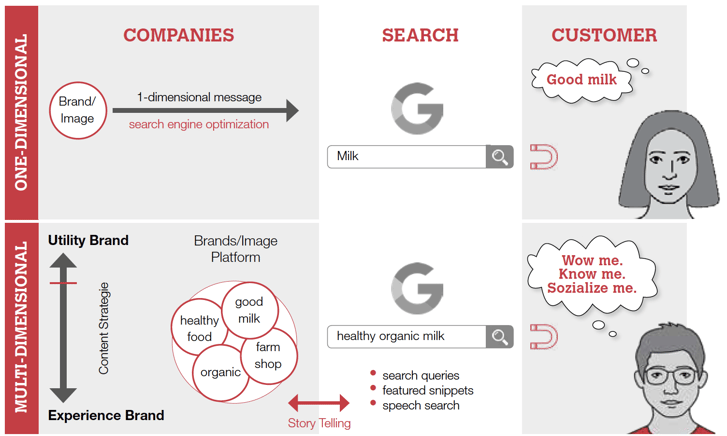Loyalty to brands is continually declining among buyers. Companies continue to invest large budgets to help consumers build brand loyalty. The measures and methods used have changed significantly with the communication opportunities offered by digitalization. Brands focus on improved customer experiences on company-owned platforms and channels. The objective is to make the content easily accessible and to ensure high traffic rates from search engines.
Every digital brand experience starts with content – content that has a positive emotional impact and meets the needs of consumers. If the content does not live up to expectations, the majority of consumers will abandon the digital purchasing process.
From customer need to brand
The deeper a company analyses consumer behavior gathers knowledge about consumers and integrates it into brand communication the easier it will be to develop a brand with loyal customers.
How to create relevant messages:
- analyse brand perception
- position the marker
- communicate brand
The starting point for emotional customer loyalty is a positive user experience. The highly recognized English management consultant and information architecture expert Peter Morville has defined levels of experience for visitors to digital offerings.
value: Added value is created from the content for the consumer.
credible: Competence, trust and authenticity are derived from the messages presented.
desirable: The design is emotionally appealing.
usable: The handling of the website is simple and optimized for all devices.
can be found: The focus is on the content. Its provision via search engine with keywords and phrases is secured.
These values are directly linked to SEO. Because the search algorithms of Google, Bing, Yandex or Baidu are eager to optimize the usefulness of the displayed results. Based on the values and needs, Google has defined four micro moments with which, in particular, millennials go online and search:

Each moment corresponds to a special need, which has to be satisfied with the search. The term "moment" indicates the impulsive action performed. If brands succeed in satisfying this need directly, they will be successful online and create a positive user experience. Every positive interaction brings new points into the loyalty account.
OnPage optimization with content strategy
Content is used strategically for brand building. In order to serve the total volume of possible consumer needs, brands operate their own platforms. On these platforms, any content from users' search queries in connection with their products and services can be published as text, video or graphics. The development is moving away from rigid claims towards brand-related storytelling.
Continuous publication of posts, content and news is a must-have. As a basis, search terms are checked in order to filter out those topics that are relevant to target groups on the one hand and to prepare these contents in such a way that they are well received on the other.
Keyword analysis
As in e-commerce, the analysis of user needs is generally based on the volume and type of search queries on specific topics. High-volume search terms and their many variations form the basis for subsequent brand communication. The keyword analysis includes the research, definition and evaluation of relevant keywords. The aim is to search for the terms used by consumers to search for offers and products online in the search engine. The results are then compared with the existing brand messages. The analyses often show that insiders from the communications department use different keywords than users who have not been familiar with the brand's products to date.
The analyses are clustered into topic areas and assigned to the various micro moments. A categorization follows along the levels in the inbound sales funnel. The Google Ads Keyword Planner or Google Suggest as well as the recently available "People-also-ask-Boxes" (PAA-Boxes) are used for this purpose.

From keyword to message
Messages are formulated from the resulting keyword collection and relevance levels. They correspond to the World of Me identities and values of the targeted consumer groups. With the core messages, the brand is positioned and defined externally. There are clearly defined guidelines for all content, which will later be used in brand communication.
From the message to brand story
Brand stories convey information about the company's products and the interaction of buyers with them in an emotional way. How people deal with the brand, how the use of the products creates safety, fun or efficiency – all these messages are presented in a variety of ways as realistic stories. The search terms of the previous keyword analysis are incorporated into the stories. One need is satisfied at a time: "to do", "to go", "to know" or "to buy". According to the consumers surveyed in the study, the greatest chance of being shared lies primarily in brand content that is informative and not too promotional.
Storytelling on Pillar Pages clusters
Pillar pages are used for semantic SEO optimization of content. They are part of the content marketing strategy. A Pillar Page introduces an important topic of the brand and already answers some questions that are asked in the Google search. Links provide further content on other pages of the platform. There, partial aspects of the topic of the pillar page can be dealt with in depth.
The complete package of pillar page and linked sub-pages results in a relevant topic cluster for the search engine and thus for consumers. The topic cluster can be planned and flexibly expanded via the mind map representation. If new content is regularly added to the pillar page, the relevance increases or remains the same, as new content is ranked higher.
Compared to the typical blog structure, users get a very good overview of the information offered on an overall topic. The pillar page, which occupies a certain keyword, remains the pivotal point for orientation. Typical long tail search phrases are placed on the associated pages. In this way, brands can prepare their various messages in several articles.
You can find further information on analyzing customer needs and a decision matrix for strategic content for search engines in our W4 white paper "SEO for modern brands".










